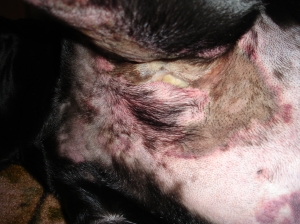Welcome to the lazy days of barbecues and swimming pools!! Make them even better by sharing them with your favorite pet. By following a few summer pet safety tips, you can keep your animal friends healthy and enjoy the months of sun and fun.
- If your dog is outside on a hot day, make sure he has a shady spot to rest in. Dog houses are not good shelter during the summer as they can trap heat. You may want to fill a child’s wading pool with fresh water for your dog to cool off in.
- Never leave a pet unattended in the car on a warm or sunny day. Cars quickly heat up to a dangerous temperature, even with the window slightly open.
- Avoid strenuous exercise on extremely hot days. Take walks in the early mornings or evenings, when the sun’s heat is less intense.
- Pet rabbits should be kept indoors because they don’t tolerate heat well. Keeping a rabbit indoors will provide protection from predators that might try to attack a rabbit in an outdoor hutch.
- Be on the lookout for early symptoms of your pet overheating: excessive panting and drooling, bright red gums, weakness, and balance problems. As the condition worsens, pets may experience labored breathing, lethargy, and even seizures. You can cool down an overheated pet with cold water or towels and by offering ice chips or small bowls of water.
- Never use any products meant for people on your pets, insect repellants, sunscreens and other products can be harmful or deadly if ingested, and at the very least can cause serious skin irritations. We recommend keeping Vet Aid Products on hand. Summer uses include but are not limited to; burns, blisters, bug bites, skin irritations.
- Ticks love pets, during tick season check your pet daily for ticks. At the start of spring check in with your vet and get the necessary flea and tick medications.
- Poisons. Keep your cleaners, insecticides and fertilizers away from your pets. Lots of pets, especially puppies and kittens, suffer fatal accidents or deaths when their curiosity leads them to explore chemicals used around the house.
- Asphalt and concrete can be very hot on the dogs feet during the summer. Walk them in grass or the evening when the sidewalks are cooler and you won’t chance burning the bottom of your dog’s feet. If by chance, your pet does burn their pads, be sure to apply Vet Aid Foam 5x daily.
- All animals are susceptible heat related stress, so in the warmer months we need to pay attention to how all of our pets are coping with the heat. For ectothermic pets like reptiles and amphibians this is especially critical. So make sure you taking every precaution with ALL pet’s during this extreme heat.
- Be prepared for any of these incidences. Vet Aid recommends always having a First Aid Kit, if you are a pet owner. Our products are a great addition to any First Aid Kit for multiple reasons; multi-use, remains sterile with multi pet use, 5 year shelf life, compact, safe and effective for ALL animals.
Please be sure to visit www.vetaidproducts.com and be prepared with Vet Aid Spray and Foam.
















